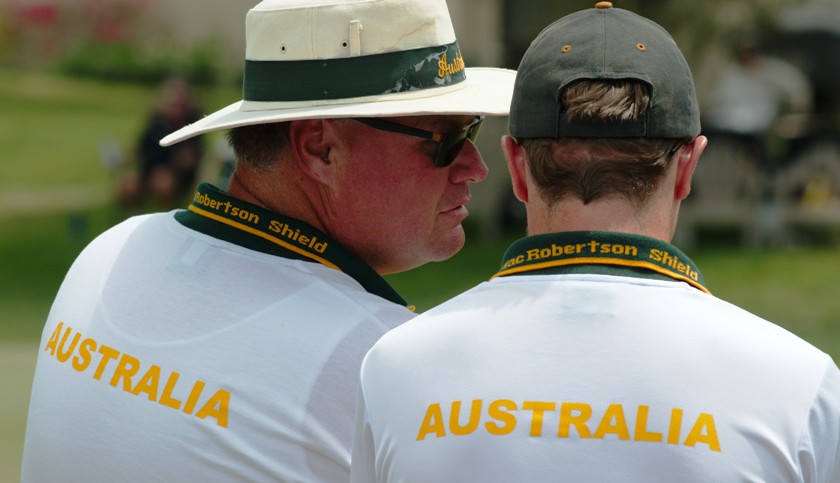Today, we are pleased to add Chris Clarke to the team of contributors for coverage of the 2017 MacRobertson Shield being held this month (and into May) in Rancho, Mirage, California. This is in addition to the players journals we have running from Jeff Soo and Paddy Chapman. Please enjoy ...
First Tests Review: England v Australia and New Zealand v USA
Day 1
The first day of any MacRobertson Shield is an exciting and nervous experience. Over the past three decades, I have seen many debutants wilt under the pressure. It therefore comes as a pleasant surprise to be able to report on two excellent debuts on day 1 of these tests. Stuart Lawrence completed two triple peels to take his match partnering Jeff Soo against Hogan and Shilling without the Kiwis even taking croquet. Stuart’s only error was failing to get going once in game two which gave away a long bonus shot.
In the other Test, James Hopgood made no errors taking breaks to 4-b on the fourth and third turns of his two games. This was perhaps an even stronger performance since his pairing with Maugham won their match without the world number one Robert Fletcher taking croquet – Robert only struck his ball twice in the match.
At about 11 o’clock, it looked as if England would take a 2-0 lead when Jamie Burch was on a finishing turn against Dumergue and Forster, when already game up. However, a blast at hoop 2 failed to go through (these hoops react better to soft and mid-pace shots) and Stephen Forster played a good finishing turn to turn Death’s tpo into an otp. The players broke for lunch at 1-1. Meanwhile over in lawn 5, Mulliner had completed the peels of a dpo only to completely miss the peg-out leaving a ball at Greg Fletcher’s hoop and conceding contact. Greg made no error and finished the match next turn to level the test 1-1.
When the deciding game resumed in the Death/Burch v Dumergue/Forster match, Burch went round 5th turn, but Forster hit the lift and Dumergue claimed the match on the 7th turn to give Australia the overnight lead. NZ and USA shared the other two doubles for the USA to lead 2-1. How critical will this turn-around be on day 5?
Day 2
England and Australia shared today's singles 3-3 to give Australia a 5-4 lead. One piece of information that may not be widely known is that Robert Fletcher broke his mallet a week ago and is still getting used to his new mallet. In his second game against Mulliner, both players had 2 breaks and both had 3 peels, but it was the player with the better tactics that won.
The USA/NZ match only finished two of their three doubles, both going to the USA to give them a 4-1 lead. The Huneycutt/Morgan v Hogan/Shilling match was pegged down after 10.5 hours. Amazingly, it was still in the second game!!
Day 3
Australia once again won the doubles 2-1 to take a 7-5 lead into day 4. Another losing tpo featured in England’s defeat. I highlighted during the last World Championships that of the 7 tpos completed, 6 of them lost and that this was a weak tactic. No lessons seem to have been learnt by the English players.
USA/NZ shared the singles 3-3 to make it 7-4 and NZ equalised at game all in the unfinished doubles which was once again pegged down after 12.5 hours.
Day 4
NZ won all three doubles and added the unfinished doubles to make it 4-0 on the day to take an 8-7 lead into the final day.
The Aus/Eng match showed an increase in both the number of errors and the strangeness of tactical choices. Whether this was due to the high temperatures, inexperience, pressure, or a combination of these three factors I do not know. To give one example of a baffling set of decisions, Greg Fletcher had completed all the peels of his triple against James Death in their deciding game, but was 1 foot in front of rover with peelee just through the hoop. He had the option to jump over and take a 9 yard return roquet, but decided to run the hoop firmly and flat. I was standing next to Ian Dumergue, the Australian Captain and commented on what a mature sensible decision Greg had made. I assumed he would croquet partner to the peg, possibly getting a long peg out and would then rush James’ balls off the boundaries to take a 25-0 lead and force a hit-in. The spectators were amazed when Greg played a hard peg-out from the south boundary where the front ball zoomed off the lawn. Following this, James, instead of going to 4-b and giving Greg one shot to stay in the match (there were 32 +26tp results in the first Tests), went to 1-b and attempted a sextuple. No-one has achieved more than 3 peels of a sextuple so far in the event and whilst it was a surprise that James didn’t even attempt the 3-b peel, it was little surprise that the turn did not finish.
Australia took 3 of the first 5 matches to finish which left them on the brink of victory at 10-7. The final match to finish was between Stephen Forster and James Hopgood. This was a tough position for a debutant to find themselves and he played some good turns. However, Forster’s experience and elegant play won through to give Australia the key 11th match win.
I have been asked in the past what Australia needed to do to win a MacRobertson. My two answers have been “select their best players” and “get a team strong enough that Forster can play lower down the order”. They fulfilled both these criteria – many congratulations to them.
Day 5
England took the doubles 2-1 to make the final score Aus 12, Eng 9. Australia selected their best six players for the first time in my memory. They also had three compatible doubles partnerships that had played together before. They came with a pre-determined game plan – and it was a good plan. Supershot openings, no TPOs, no sextuples. Just solid play. Finally, they executed their game plan well, and were worthy winners.
The other test match was a nail-biter, in true MacRobertson Shield spirit. The last two matches finished within 30 seconds of each other at dusk. USA had started the day 8-7 down, but had moved to 10-9 ahead before kiwi debutants Aiken Hakes and Chris Shilling put the final two matches on the scoreboard to allow New Zealand an 11-10 win.
I mentioned on Day 1 two strong debuts by Hopgood and Lawrence. What is perhaps more difficult to do is to get off to a bad start and find fabulous form by the end of a test. Chris Shilling didn’t take croquet on the first day, and today produced a level of performance combined with maturity that I will remember for a long time. It is also probably an opportune moment to thank Toby Garrison for his willingness to play one test match at short notice. His contribution to the team has been immense.
The American team produced a good standard of play for most of the Test. It was a Test that could easily have gone either way and there was little to choose between the two sides. One statistic that may be of surprise to readers is that NZ only won one of the five days of play.
Looking forward to the second tests, New Zealand lose Toby Garrison and gain Harps Tahurangi. USA gain Matthew Essick, but at this stage, it is unknown who he will replace. Despite Danny Huneycutt’s match win against Hogan today, I feel he was the least on-form of the Americans, and I wouldn’t be surprised if he chose to sit out the second test.
The standard of play in the Aus/Eng Test was much higher than the USA/NZ Test and if all the teams continue to play at that level, it wouldn’t surprise me to see 17-4 or 16-5 results in favour of Australia and England in the second Tests. However, croquet is a sport and anything can happen, however unlikely. Sunday is a rest day and the second Tests start on Monday. All the players will welcome a break from the searing heat. Check back to Croquet Network for more next week.

